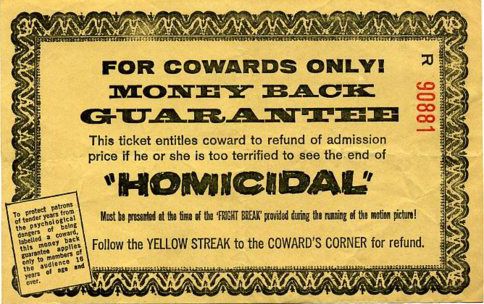Odds and Sods

In fact, Hollywood tried this more than 50 years ago, when filmmakers pushed the boundaries of the movie-going experience to make it more interactive. The gimmick craze of the 1950s put special effects in your face and under your seat, literally: Some audiences got a whiff of the action in scented screenings, while others were jolted out of their seats by electric buzzers.

In the 1950s, theater owners and movie promoters reacted to the popularity of TV by offering stranger and stranger gimmicks in theaters, like interactive "experiences." The master of such gimmickry was film producer and director William Castle, who understood the value of publicity.
Many of Castle’s gags were integrated directly into the movie, bringing stories to life by letting the audience interact with the action onscreen. For his 1961 film, “Homicidal,” Castle inserted a “fright break” just before the film’s climax, displaying a ticking stop-watch while giving viewers a chance to leave the theater if they were too afraid. Theaters set up a “Coward’s Corner” in the lobby, with a yellow line leading fearful patrons to the booth where they’d sign a certificate stating “I am a bona-fide coward” before getting their money back.

Audiences couldn’t wait to see what Castle would come up with next. For the film “Thirteen Ghosts,” black-and-white scenes were superimposed with blue- and red-tinted footage, allowing viewers to make the “ghosts” visible or invisible using a pair of “Illusion-O” glasses filled with colored cellophane. For “Mr. Sardonicus,” Castle created a “Punishment Poll,” whereby audience members could vote for the villain to receive extra punishment or mercy. While many skeptics think there weren’t actually two endings, Terry says an alternate version was definitely made, though it wasn’t ever screened.By the time Castle produced his last film, 1967's Rosemary's Baby, others had learned from his promotional stunts. They continue up to the 21st-century revival of 3D movies. Read about Castle and others who tried every angle to make going to the theater a one-of-a-kind experience at . Collectors Weekly.

No comments:
Post a Comment